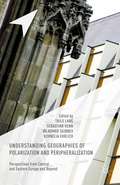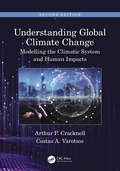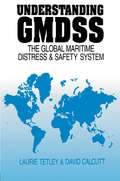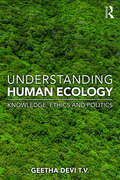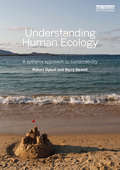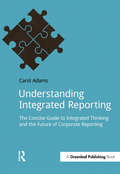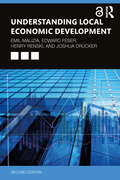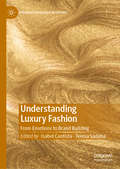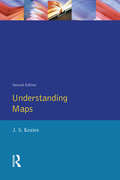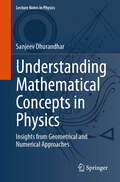- Table View
- List View
Understanding Ethiopia
by Frances M. WilliamsUnderstanding Ethiopia is a detailed description of Ethiopia's geological story and enables non-specialist readers to share the author's thrill at gaining a deeper insight into the processes which produced, and continue to shape, this amazing country. Ethiopia's spectacular landscapes, ranging from mountains over 4500m high to salt plains 150m below sea level, are a reflection of the geological processes that formed the country. Indeed, its history and the historical sites, for which it is renowned, are largely determined by geology. Readers learn why and how Ethiopia's geology is both unique and dynamic, as here the earth's crust is in the process of breaking apart.
Understanding G4: The Concise Guide to Next Generation Sustainability Reporting (Doshorts Ser.)
by Elaine CohenShould you or your clients report using the new G4 sustainability reporting framework? What's the significance of the changes and how do they affect you? What is the right reporting level for your company? What should you do next...?Sustainability reporting is here to stay and expanding its influence. The Global Reporting Initiative (GRI) G4 Sustainability Reporting Framework was launched in May 2013, with the publication of two manuals, adding up to 300 pages of technical guidance. Since then thousands of reporters have been hoping for a short and definitive guide to this new reporting paradigm. This is it!In this expert guide to G4, Elaine Cohen presents an easy-to-follow review of everything any company needs to know in order to decide whether to use the G4 Framework and if so, how. If you want to know what G4 means for corporate reporters, whether they are first-timers, SMEs, experienced global companies or existing GRI reporters at any level, this book is for you. It will give you the answers you need to make decisions, in a user-friendly format, and help you deliver greater value to your own company or your client companies.This book will also help users of reports know what to expect from the new generation of G4 Sustainability Reports and reporting consultants, as they advise clients on reporting process, content and disclosure.
Understanding Geographies of Polarization and Peripheralization: Perspectives from Central and Eastern Europe and Beyond (New Geographies of Europe)
by Thilo Lang Sebastian Henn Wladimir Sgibnev Kornelia EhrlichThis book presents a multifaceted perspective on regional development and corresponding processes of adaptation and response, focusing on the concepts of polarization and peripheralization. It discusses theoretical and empirical foundations and presents several compelling case studies from Central and Eastern Europe and beyond.
Understanding German Real Estate Markets
by Wolfgang Maennig Tobias JustReal estate is the biggest real asset class in an economy, and Germany is the biggest economy in Europe. This implies opportunities as well as specific risks for investors and policy makers. As the German real estate markets have by and large been spared severe disruptions in the course of the economic crisis, many questions arise for investors and academics alike. What are the key institutional characteristics of the German real estate markets that make it different? What are the short and long-term drivers of demand and supply? Which regional and functional market segments are most likely to outperform in the next few years? What are the most important pitfalls for investors in Germany? This book gives answers to these and many more questions. The editors have invited a broad range of extensively knowledgeable practitioners and academics from across the relevant real estate spectrum, i.e. economic, legal, tax, planning and financing issues, to express their views. There is no better English publication that gives such a profound and simultaneously entertaining overview of Germany's real estate markets.
Understanding German Real Estate Markets (Management for Professionals)
by Tobias Just and Wolfgang MaennigReal estate is the biggest real asset class in an economy, and Germany is the biggest economy in Europe. This implies opportunities as well as specific risks for investors and policy makers. As the German real estate markets have by and large been spared severe disruptions in the course of the economic crisis, many questions arise for investors and academics alike. What are the key institutional characteristics of the German real estate markets that make it different? What are the short and long-term drivers of demand and supply? Which regional and functional market segments are most likely to outperform in the next few years? What are the most important pitfalls for investors in Germany? This book gives answers to these and many more questions. The editors have invited a broad range of extensively knowledgeable practitioners and academics from across the relevant real estate spectrum, i.e. economic, legal, tax, planning and financing issues, to express their views. There is no better English publication that gives such a profound and simultaneously entertaining overview of Germany’s real estate markets.
Understanding GIS through Sustainable Development Goals: Case Studies with QGIS
by Paul HollowayUnderstanding GIS through Sustainable Development Goals applies a pedagogical shift to learning GIS, as the readers employ the concepts and methodologies on real-world problems. This book provides 16 case studies across most of the Sustainable Development Goals (SDGs) with step-by-step practical instructions using QGIS(Quantum Geographic Information System) , an open-source software. It helps readers develop GIS skills on real-world data, while learning the fundamentals including spatial data models, projections, and spatial databases, different cartographic methods, such as graduated symbology, change maps, and dynamic visualization, as well as more intermediate and advanced spatial analysis such as geoprocessing, multiple criteria analysis, and spatial statistics. The topics chosen are taught in secondary and tertiary education institutions which make this a textbook for all students and educators. Features: Focuses on learning GIS through 16 real world case studies. Introduces an open-source software that can be used beyond the classroom. Analyzes Sustainable Development Goals in a global framework and provides an alternative approach to learning GIS. Supports both secondary and tertiary educators and improves GIS education at all levels. Contains a holistic range of case studies that extend across several disciplines, from geography education, environmental sciences, geosciences, natural sciences, social sciences, and digital humanities. This is a textbook for all students and educators, providing 16 case studies across most of the SDGs with step-by-step practical instructions using QGIS, an open-source software.
Understanding Global Climate Change: Modelling the Climatic System and Human Impacts
by Arthur P Cracknell Costas A VarotsosClimate change, a familiar term today, is far more than just global warming due to atmospheric greenhouse gases including CO2. In order to understand the nature of climate change, it is necessary to consider the whole climatic system, its complexity, and the ways in which natural and anthropogenic activities act and influence that system and the environment. Over the past 20 years since the first edition of Understanding Global Climate Change was published, not only has the availability of climate-related data and computer modelling changed, but our perceptions of it and its impact have changed as well. Using a combination of ground data, satellite data, and human impacts, this second edition discusses the state of climate research today, on a global scale, and establishes a background for future discussions on climate change. This book is an essential reference text, relevant to any and all who study climate and climate change. Features Provides a thought-provoking and original approach to the science of climate. Emphasises that there are many factors contributing to the causation of climate change. Clarifies that while anthropogenic generation of carbon dioxide is important, it is only one of several human activities contributing to climate change. Considers climate change responses needed to be undertaken by politicians and society at national and global levels. Totally revised and updated with state-of-the-art satellite data and climate models currently in operation around the globe.
Understanding Global Crises: From Covid to Climate Change and Economic Collapse
by Thomas R. SadlerUnderstanding Global Crises is an innovative and interdisciplinary text that investigates the key contemporary economic, social, and environmental crises and demonstrates their deep interconnection. Contributing to the discussion of large-scale crises, this book provides a conceptual framework to understand the current global landscape. Essential cascading crises topics, such as economic collapse, climate change, racial injustice, domestic violence, and epistemic oppression, are explored in order to equip readers with the clarity to understand global crises, assess policy interventions, and analyze social responses. To achieve future resilience, the book shows that society must recognize various forms of inequality and make policy changes. Each chapter showcases an international case study, covering real-life examples of topics such as climate disinformation, vaccine distribution disparities, environmental racism, and socioeconomic deprivation. Other features of the book include key terms, suggested further reading, and discussion questions, as well as online supplements comprising PowerPoint slides and an instructor’s guide. Understanding Global Crises will be a valuable text to support courses in economics, environmental studies, political science, public health, and social policy.
Understanding GMDSS
by David Calcutt Laurie TetleyThis is the first book to cover the Global Marine Distress and Safety System (GDMSS) in a comprehensive and readable way. GDMSS is now being developed to provide a new global communications and locating network to alert search and rescue services, and all students of navigation or maritime technology, and practising navigation officers, will need to be trained in its use. This accessible reference textbook provides students and new radio operators with all the knowledge necessary for a complete understanding of GMDSS and its related systems.
Understanding God’s World
by Dawn MerenessThe Author describes GOD's creation in his books, about Science, Insects, Plants, Birds, Water, Air, Weather, Sound and Hearing. Geology, Planet Earth, Oceanography, Wonders of the Sea and Astronomy.
Understanding Green Building Guidelines: For Students and Young Professionals
by Traci Rose RiderSummarizes the main issues and strategies of the forceful and fast-paced green building movement. Many professions are increasingly producing tools to assist clients in breaking down and understanding the different elements that reside under the umbrella of the sustainability movement. For the design and construction professions, this unpacking often takes the form of green building guidelines and rating systems. This book aims to look at a selection of both national and local green building rating systems and guidelines, ranging from commercial to residential. While the goal is to provide students and young professionals with a solid overview of each product, enabling them to understand the differences and select the most appropriate system for their chosen projects, the book provides valuable overviews and comparisons for anyone interested in better buildings: designers, homeowners, realtors, contractors, facility managers, site designers, and more.
Understanding Green Building Materials
by Jessica Mcnaughton Traci Rose Rider Stacy GlassA companion to Understanding Green Building Guidelines, this primer explains green building products--what they are and how to choose them. From eco-friendly sheetrock to sustainable paint finishes, the green building movement is gaining momentum. But with new products, manufacturers, and standards being introduced routinely, how are architects or designers to know what's best for their projects? This book summarizes what is available and the considerations for selecting sustainable materials.
Understanding Human Ecology: Knowledge, Ethics and Politics
by Geetha Devi T. V.This book examines the domain of human agency–environment interaction from a multidimensional point of view. It explores the human–environment interface by analysing its ethical, political and epistemic aspects – the value aspects that humans attribute to their environment, the relations of power in which the actions and their consequences are implicated and the meaning of human actions in relation to the environment. The volume delineates the character of this domain and works out a theoretical framework for the field of human ecology. This book will be a must-read for students, scholars and researchers of environmental studies, human ecology, development studies, environmental history, literature, politics and sociology. It will also be useful to practitioners, government bodies, environmentalists, policy makers and NGOs.
Understanding Human Ecology: A Systems Approach to Sustainability
by Robert Dyball Barry NewellUnderstanding Human Ecology offers a coherent conceptual framework for human ecology – a clear approach for understanding the many systems we are part of and for how we frame and understand the problems we face. Blending natural, social, and cognitive sciences with dynamical systems theory, this key text offers systems approaches that are accessible to all, from the undergraduate student to policymakers and practitioners across government, business, and community. In the first edition, road-tested and refined over a decade of teaching and workshops, the authors built a clear, inspiring, and important framework for anyone approaching the management of complex problems and the transition to sustainability. Fully updated for the second edition, the book now goes further in using systems-thinking principles to explain fundamental processes of change in social–ecological systems. Revised case examples provide a working application of these principles, whilst a new discussion of the hierarchical structure of complex systems is included to guide practical policymaking. This new edition is essential reading for students and scholars of human ecology, environmental ethics, and sustainability studies.
Understanding Human Ecology: A systems approach to sustainability
by Barry Newell Robert DyballWe are facing hugely complex challenges - from climate change to world poverty, our problems are part of an inter-related web of social and natural systems. Human Ecology provides an approach to address these complex challenges, a way to understand them holistically and to start to manage them more effectively. This textbook, which has been road-tested and refined through over a decade of teaching and workshops, offers a coherent conceptual framework for Human Ecology - a clear approach for understanding the many systems we are part of and how we frame and understand the problems we face. By giving rigorous definitions it guides readers out of the current 'conceptual swamp' that hinders communication and collaboration - with a particular focus on terms such as "sustainability" and "cultural adaptation", that need generally agreed definitions before they can support clear communication. It also clarifies the role of Human Ecology, and similar disciplines, by bringing ethical and justice considerations into the assessment of different interventions to promote sustainability. Blending natural, social and cognitive sciences with dynamical systems theory, the authors offer systems approaches that are accessible to all, from the undergraduate student in environmental studies to policy-makers and practitioners across government, business and community.
Understanding Human-Nature Practices for Environmental Management: Examples from Northern Europe (Routledge Explorations in Environmental Studies)
by E. C. H. KeskitaloNature has often been understood in literature through a disjunction to human systems. This can be seen in the nature-culture binary, or even more clearly in the opposition of ‘wilderness’ to ‘civilization’.Drawing on historical and present-day examples and case studies from Northern Europe, this book critically examines the ways in which the use of such dichotomies can be transcended to respond to sustainability challenges. Using illustrative examples, the authors demonstrate how shared histories and development of land use continue to impact multiple practices today. The book explores the prerequisites for environmental management approaches that counterpose the nature-culture binaries that are present in existing governance mechanisms.This volume will be of great interest to students and scholars of environmental management, environmental law and policy and environmental anthropology.
Understanding Imperiled Earth: How Archaeology and Human History Can Inform Our Planet's Future
by Todd J. BrajeA unique introduction to how understanding archaeology can support modern-day sustainability efforts, from restoring forested land to developing fire management strategiesAn essential and hopeful book for climate-conscious readersThe world faces an uncertain future with the rise of climate change, biodiversity loss, deforestation, overfishing, and other threats. Understanding Imperiled Earth meets this uncertainty head-on, presenting archaeology and history as critical guides to addressing the modern environmental crisis.Anthropologist Todd J. Braje draws connections between deep history and today's hot-button environmental news stories to reveal how the study of the ancient past can help build a more sustainable future. The book covers a diverse array of interconnected issues, including: how modern humans have altered the natural world conservation work of Indigenous communitiesextinction of megafauna like dire wolves and woolly rhinocerosthe risk of deforestation highlighted by Notre Dame's destructionthe extinction crisis reflected by endangered bird species in Hawai'ifish scarcity driving demand and price, like the single blue-fin tuna fish that sold for three million dollarsimportance of "action archaeology" Braje examines how historical roots offer a necessary baseline for a healthier Earth, because understanding how the planet used to be is fundamental to creating effective restoration efforts moving forward through urban forests, sustainable food webs, and more. Understanding Imperiled Earth offers an illuminating, hopeful, and actionable approach to some of the world's most urgent problems.
Understanding Innovation in Emerging Economic Spaces: Global and Local Actors, Networks and Embeddedness (The Dynamics of Economic Space)
by Grzegorz MicekA small number of countries, regions, cities, and localities are powerful gatekeepers and generate the bulk of creative and innovative ideas, while the majority is largely excluded. This book looks at neglected, but emerging innovation centres analysed from various spatial and organizational perspectives; ranging from entire countries and regions to individual firms and small neighbourhoods. Bringing together leading scholars from various disciplines, it examines a variety of economic sectors including biotechnology, agrotourism, and the food retail industry. The authors employ various, often contradictory, concepts, ranging from local buzz and the global pipeline, through an analysis of collective learning processes to geographical embeddedness, using both qualitative and quantitative approaches. The purpose of the book is twofold: investigating changes occurring in the regions and cities under transformation and attempting to find common and unique mechanisms behind these changes. Consequently, the authors shed light on the scale and scope of the innovativeness of selected economic and social processes.
Understanding Integrated Reporting: The Concise Guide to Integrated Thinking and the Future of Corporate Reporting
by Carol AdamsIntegrated Reporting is the big new development in corporate reporting that everyone is talking about. Why? Quite simply, Integrated Reporting marks a paradigm shift in the way companies and other organizations think about business models and the creation of value. Integrated Reporting promotes long term thinking about value-creation and stewardship across a broad base of interdependent capitals – financial, manufactured, human, intellectual, natural, and social and relationship.With updated references and case studies to take account of the latest developments in Integrated Reporting, this book provides a practical and expert distillation of for IR professionals.Internationally renowned sustainability reporting expert and accountant Dr Carol Adams explains in simple terms what is and how to do it; how it links with other reporting frameworks and what it means in terms of thinking and processes. You'll also get a clear business case for IR and insights and best practice examples from leading integrated reporters. Integrated Reporting is not just for companies.This book demonstrates how integrated thinking and IR can benefit many other organizations whose success and influence depends on relationships and partnerships.
Understanding Just Sustainabilities from Within: A Case Study of a Shared-Use Commercial Kitchen in Connecticut (Routledge Equity, Justice and the Sustainable City series)
by Phoebe GodfreyWritten by the co-founder and former board president of a non-profit shared-use commercial kitchen, Understanding Just Sustainabilities from Within presents an intersectional analysis of CLiCK (Commercially Licensed Co-operative Kitchen), in order to explore what just sustainabilities can look and feel like from within and without. Through a unique combination of auto ethnography, participant observation, surveys and secondary research, this book offers insights into CLiCK’s micro and macro successes, failures, and unknowns in relation to its attempt to put the concept of just sustainabilities into daily practice, and praxis. Developing its practical analyses from a theoretical basis, this book does not focus on definitive answers, recognizing instead that the closest we can get to understanding just sustainabilities in praxis is through long-term collective struggle and ultimately love. Researchers and educators who are interested in linking theory with practice, especially in relation to just Sustainabilities and intersectionality, will appreciate the theoretical grounding, making it desirable for multiple social science classes. Additionally, those involved with the social justice, food justice and just sustainabilities movements will benefit from the book’s insights into best practices to address issues of social inequalities on the micro level, while also offering the benefits of a macro intersectional analysis.
Understanding Local Economic Development: Second Edition
by Emil Malizia Edward J. Feser Henry Renski Joshua DruckerThis book offers insights into the process and the practice of local economic development. Bridging the gap between theory and practice, it demonstrates the relevance of theory to inform local strategic planning in the context of widespread disparities in regional economic performance. The book summarizes the core theories of economic development, applies each theory to professional practice, and provides detailed commentary on them. This updated second edition includes more recent contributions—regional innovation, agglomeration, and dynamic theories—and presents the major ideas that inform economic development strategic planning, particularly in the United States and Canada. The text offers theoretical insights that help explain why some regions thrive while others languish and why metropolitan economies often rise and fall over time. Without theory, economic developers can only do what is politically feasible. This book, however, provides them with a logical tool for thinking about development and establishing an independent basis on which the local consensus needed for evidence-based action undertaken in the public interest can be built. Offering valuable perspectives on both the process and the practice of local and regional economic development, this book will be useful for both current and future economic developers to think more profoundly and confidently about their local economy.
Understanding Local Economic Development: Second Edition
by Emil Malizia Edward J. Feser Henry Renski Joshua DruckerThis book offers insights into the process and the practice of local economic development. Bridging the gap between theory and practice it demonstrates the relevance of theory to inform local strategic planning in the context of widespread disparities in regional economic performance.The book summarizes the core theories of economic development, applies each of these to professional practice, and provides detailed commentary on them. This updated second edition includes more recent contributions - regional innovation, agglomeration and dynamic theories – and presents the major ideas that inform economic development strategic planning, particularly in the United States and Canada. The text offers theoretical insights that help explain why some regions thrive while others languish and why metropolitan economies often rise and fall over time. Without theory, economic developers can only do what is politically feasible. This text, however, provides them with a logical tool for thinking about development and establishing an independent basis from which to build the local consensus needed for evidence-based action undertaken in the public interest.Offering valuable perspectives on both the process and the practice of local and regional economic development, this book will be useful for both current and future economic developers to think more profoundly and confidently about their local economy.The Open Access version of this book, available at http://www.taylorfrancis.com, has been made available under a Creative Commons Attribution-Non Commercial-No Derivatives (CC-BY-NC-ND) 4.0 license.
Understanding Luxury Fashion: From Emotions to Brand Building (Palgrave Advances in Luxury)
by Teresa Sádaba Isabel CantistaOffering an original contribution to the field of luxury and fashion studies, this edited collection takes a philosophical perspective, addressing the idea that humans need luxury. From this framework it delves deep into two particular dimensions of luxury, emotions and society, and concludes with cases of brand building in order to illustrate the two dimensions at work. Comparative analysis between countries is brought together with an emphasis on China. Chapters address the ongoing growth in the market, as well as the significant changes in the sector brought about by fast international expansion and an increased focus on ethical supply and sustainability, making the book an insightful read for scholars of fashion business, luxury and branding.
Understanding Maps
by J. S. KeatesAddresses the fundamental principles of visual perception and map symbolism and critically examines the assumptions behind the theories of psychophysical testing and cartographic communication. This revised and expanded edition includes new sections on the relationship between cartography and art, and the distinction between knowledge and skill.
Understanding Mathematical Concepts in Physics: Insights from Geometrical and Numerical Approaches (Lecture Notes in Physics #1030)
by Sanjeev DhurandharModern mathematics has become an essential part of today’s physicist’s arsenal and this book covers several relevant such topics. The primary aim of this book is to present key mathematical concepts in an intuitive way with the help of geometrical and numerical methods - understanding is the key. Not all differential equations can be solved with standard techniques. Examples illustrate how geometrical insights and numerical methods are useful in understanding differential equations in general but are indispensable when extracting relevant information from equations that do not yield to standard methods. Adopting a numerical approach to complex analysis it is shown that Cauchy’s theorem, the Cauchy integral formula, the residue theorem, etc. can be verified by performing hands-on computations with Python codes. Figures elucidate the concept of poles and essential singularities. Further the book covers topology, Hilbert spaces, Fourier transforms (discussing how fast Fourier transform works), modern differential geometry, Lie groups and Lie algebras, probability and useful probability distributions, and statistical detection of signals. Novel features include: (i) Topology is introduced via the notion of continuity on the real line which then naturally leads to topological spaces. (ii) Data analysis in a differential geometric framework and a general description of χ2 discriminators in terms of vector bundles. This book is targeted at physics graduate students and at theoretical (and possibly experimental) physicists. Apart from research students, this book is also useful to active physicists in their research and teaching.


